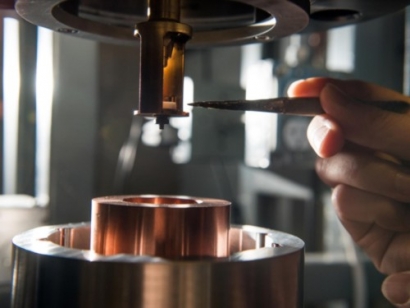
The Hydrogen Materials Compatibility Consortium — or H-Mat — is conducting early-stage research to understand how hydrogen affects polymers and metals used in infrastructure to store, transport, compress, and dispense the fuel. The consortium’s goal is to improve the reliability and durability of materials used in hydrogen infrastructure while also identifying alternative, less expensive materials that reduce equipment replacement cycles and downtime at fueling stations.
The research collaboration includes industry, academia, and three additional national laboratories—Oak Ridge National Laboratory, Savannah River National Laboratory, and Argonne National Laboratory. The consortium supports the DOE’s H2@Scale initiative, launched by the Office of Energy Efficiency and Renewable Energy’s Fuel Cell Technologies Office. The focus of H2@Scale is to advance affordable wide-scale hydrogen production, transport, storage, and utilization to unlock revenue potential and value across sectors.
The use of hydrogen in fuel cells is growing rapidly for multiple applications. Beyond transportation applications, the use of hydrogen can add value in stationary energy storage for the grid and backup power, and for industrial sectors like steel manufacturing and ammonia production.
Hydrogen also happens to be a very small and reactive molecule that can cause materials to behave differently than they would in air. These differences mean developers must engineer components such as metal tanks, polymer hoses, and seals that can withstand repeated cycling of materials from high to low pressure. Identifying and developing materials that are more resistant to degradation will increase component lifetimes and reduce maintenance requirements.
In order to develop better materials, though, the research team must understand how hydrogen interacts with materials. The team, which comprises world-class scientists who have been recognized for their expertise in polymer and steel hydrogen compatibility, will work over a four-year period to enhance durability and lower costs of seals and storage vessels.
This research will be relevant to many current and emerging applications, including hydrogen storage, onboard fuel cell vehicles, hydrogen fueling stations, and hydrogen energy storage. The team will develop strategies to select or design improved materials using a combination of advanced computation and unique experimental facilities across the national laboratory system.
The Hydrogen Effects on Materials Laboratory at Sandia is one of a few research facilities in the United States that allows for the mechanics of materials to be studied in high-pressure hydrogen. Sandia is focusing on the metals portion of the study.
PNNL is focused on the polymers portion of the study. PNNL’s Hydrogen Polymers Characterization Laboratory houses unique capabilities for measuring degradation of polymers, including a high-pressure, in-situ dynamic mechanical analyzer to study pressure and gas effects on non-metallic materials and other specialized instruments that measure friction and wear on sealing materials.
Additionally, imaging capabilities and physical metallurgy expertise at Oak Ridge, imaging/testing resources at Savannah River, and chemical analysis capabilities at Argonne will inform the consortium’s research.
The non-proprietary data obtained as part of the H-Mat Consortium is being made publicly available to accelerate national research and development in materials compatibility.
Information provided by PNNL
Photo: Researchers at PNNL evaluate changes in materials designed to provide seals and barriers to hydrogen gas. As hydrogen gas diffuses into the materials, pressure and temperature fluctuations can cause changes in the properties and volume.
Andrea Starr | PNNL

